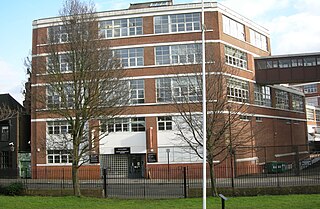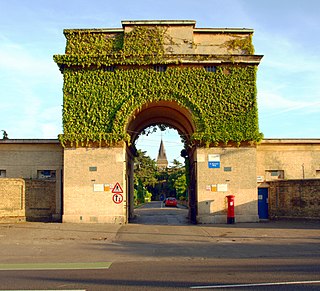
In Britain and Ireland, a workhouse was an institution where those unable to support themselves financially were offered accommodation and employment. In Scotland, they were usually known as poorhouses. The earliest known use of the term workhouse is from 1631, in an account by the mayor of Abingdon reporting that "we have erected wthn [sic] our borough a workhouse to set poorer people to work".

The London Metropolitan Archives (LMA) is the principal local government archive repository for the Greater London area, including the City of London: it is the largest county record office in the United Kingdom. It was established under its present name in 1997, having previously been known as the Greater London Record Office. It is administered and financed by the City of London Corporation.

NYC Health + Hospitals, officially the New York City Health and Hospitals Corporation (HHC), operates the public hospitals and clinics in New York City as a public benefit corporation.

The Lunacy Act 1845 or the Lunatics Act 1845 and the County Asylums Act 1845 formed mental health law in England and Wales from 1845 to 1890. The Lunacy Act's most important provision was a change in the status of mentally ill people to patients.

Leyton was a local government district in southwest Essex, England, from 1873 to 1965. It included the neighbourhoods of Leyton, Leytonstone and Cann Hall. It was suburban to London, forming part of the London postal district and Metropolitan Police District. It now forms the southernmost part of the London Borough of Waltham Forest in Greater London.

The Local Government Act 1929 was an act of the Parliament of the United Kingdom that made changes to the Poor Law and local government in England and Wales.

St Bernard's Hospital, also known as Hanwell Insane Asylum and the Hanwell Pauper and Lunatic Asylum, was an asylum built for the pauper insane, opening as the First Middlesex County Asylum in 1831. Some of the original buildings are now part of the headquarters for the West London Mental Health NHS Trust (WLMHT).
The Metropolitan Asylums Board (MAB) was established under Poor Law legislation to deal with London's sick and poor. It was established by the Metropolitan Poor Act 1867 and dissolved in 1930, when its functions were transferred to the London County Council.

Yarra Bend Asylum was the first permanent institution established in Victoria that was devoted to the treatment of the mentally ill. It opened in 1848 as a ward of the Asylum at Tarban Creek in New South Wales. It was not officially called Yarra Bend Asylum until July 1851 when the Port Phillip District separated from the Colony of New South Wales. Prior to the establishment of Yarra Bend, lunatic patients had been kept in the District's gaols. Yarra Bend was proclaimed an Asylum under the provisions of the Lunacy Statute 1867 (No.309) in the Government Gazette in October 1867.

The Cleveland Street Workhouse is a Georgian property in Cleveland Street, Marylebone, built between 1775 and 1778 for the care of the sick and poor of the parish of St Paul Covent Garden under the Old Poor Law. From 1836, it became the workhouse of the Strand Union of parishes. The building remained in operation until 2005 after witnessing the complex evolution of the healthcare system in England. After functioning as a workhouse, the building became a workhouse infirmary before being acquired by the Middlesex Hospital and finally falling under the NHS. In the last century it was known as the Middlesex Hospital Annexe and the Outpatient Department. It closed to the public in 2005 and it has since been vacated. On 14 March 2011 the entire building became Grade II Listed. Development of the site began in 2019 by current owner University College London Hospitals (UCLH) Charity as a mixed-use development including residential, commercial and open space, but construction has been held up by the necessity to remove human remains stemming from the use of the area around the workhouse as a parish burial ground between 1780 and 1853. There has also been controversy about the amount of social housing to be included in the development.

Grangegorman is an inner suburb on the northside of Dublin city, Ireland. The area is administered by Dublin City Council. It was best known for decades as the location of St Brendan's Hospital, which was the main psychiatric hospital serving the greater Dublin region. As of 2020, the area is the subject of a major redevelopment plan, running for more than a decade, under the aegis of the Grangegorman Development Agency, including the new Technological University Dublin campus.

The Diseases Prevention (Metropolis) Act was an Act of Parliament of the United Kingdom passed in 1883, during the reign of Queen Victoria.

Joyce Green Hospital was a hospital near Dartford, Kent, England. It opened in 1903 as an isolation hospital. In later years it was a training hospital. The hospital was closed in 2000 and the buildings were demolished. The greenspace where the hospital used to stand is known as Joyce Green.

St Alfege's Hospital was a hospital that operated in the Maze Hill area of east Greenwich in southeast London. It operated as the Greenwich Union Infirmary from 1874 to 1929. It was briefly known as the Greenwich and Deptford Hospital before becoming St Alfege's Hospital in 1931. It was then superseded by Greenwich District Hospital in 1968.

Highgate Hospital was a name used to refer to the infirmary building which opened in 1869 on the St Pancras side of Dartmouth Park Hill in Highgate, London.
The Bedwellty Union Workhouse was situated in Georgetown, Tredegar. It is 2.9 miles (4.7 km) from the Nanybwtch Junction A465. The building was in existence for approximately 127 years. The workhouse building was also used as a hospital. Today, the site where the building once stood, there is a housing estate known as St James Park.
St James' Hospital was a healthcare facility in Balham, London that existed between 1910 and 1988. The hospital buildings occupied sites within the boundary of Ouseley Road, Sarsfield Road and St James's Drive Balham London SW12.
Workhouse infirmaries were established in the nineteenth century in England. They developed from the Workhouse and were run under the Poor law regime.
Mental health in the United Kingdom involves state, private and community sector intervention in mental health issues. One of the first countries to build asylums, the United Kingdom was also one of the first countries to turn away from them as the primary mode of treatment for the mentally ill. The 1960s onwards saw a shift towards Care in the Community, which is a form of deinstitutionalisation. The majority of mental health care is now provided by the National Health Service (NHS), assisted by the private and the voluntary sectors.

The Heavitree Hospital (currently branded as the Royal Devon and Exeter Hospital (Heavitree)) is a hospital currently operated by the Royal Devon University Healthcare NHS Foundation Trust, as a satellite site of the Royal Devon and Exeter Hospital with its main site a short distance away at Wonford. The hospital started as the Exeter Workhouse, and was also known as the Exeter City Hospital.













